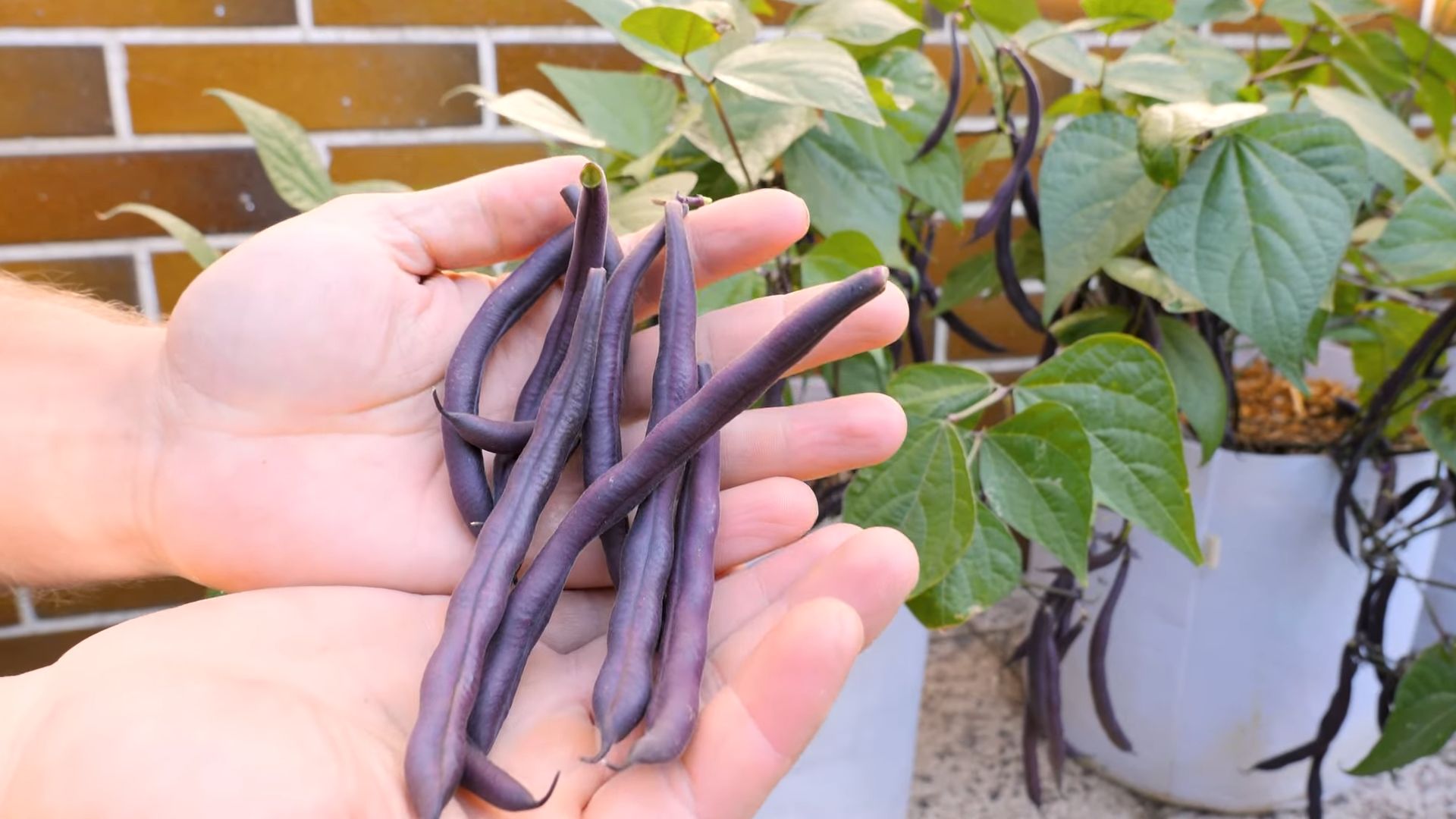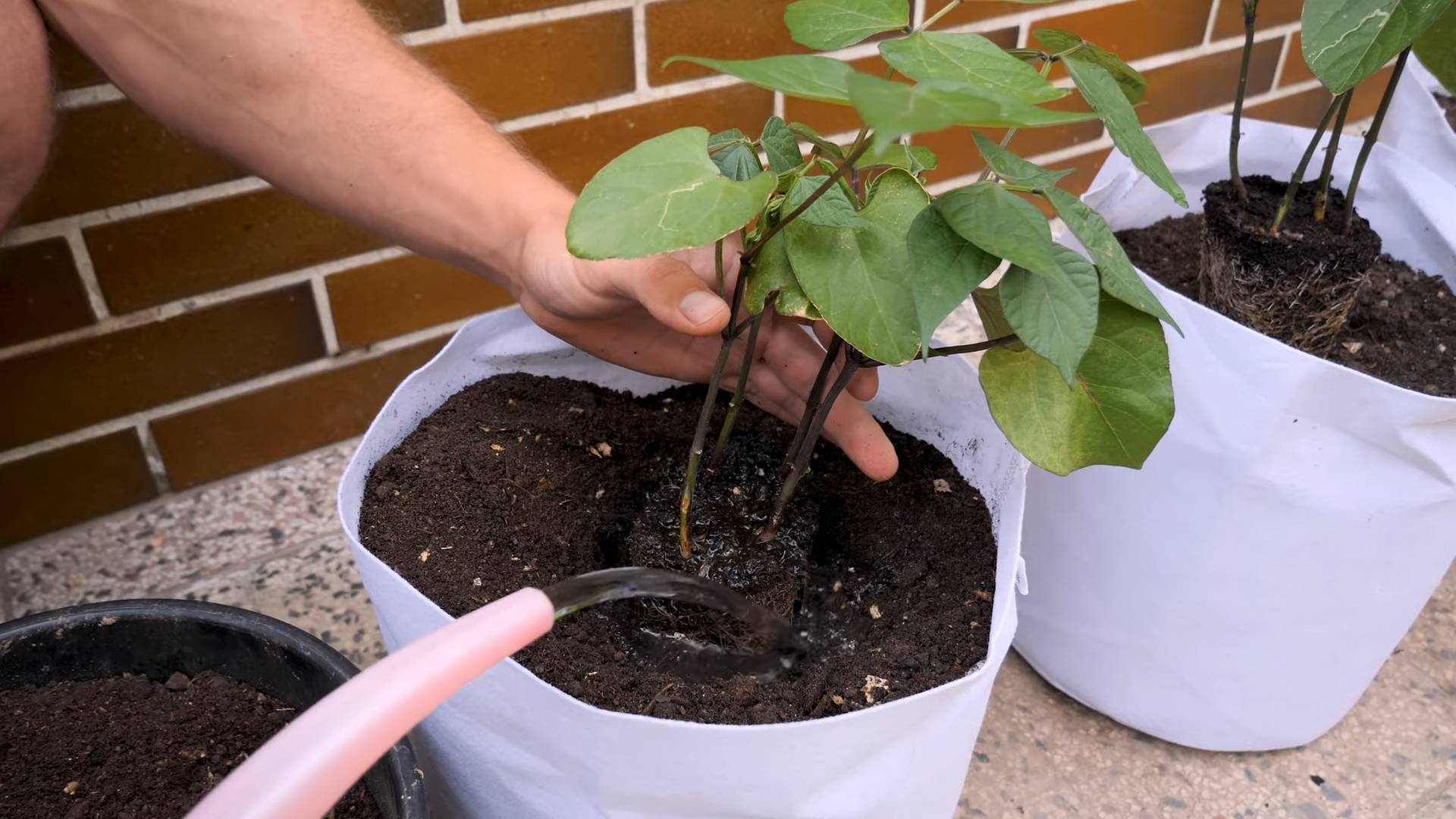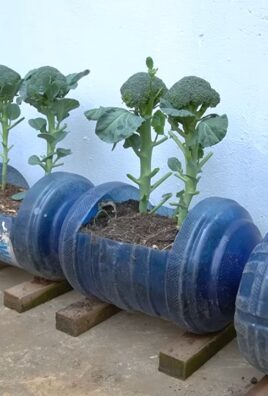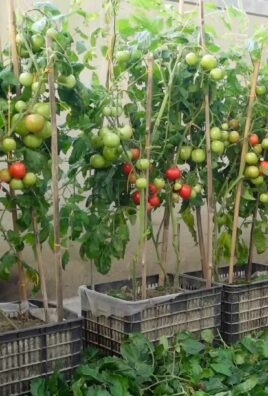Growing Purple Bush Beans might sound like something only seasoned gardeners can achieve, but trust me, it’s easier than you think! Have you ever dreamt of strolling through your backyard, plucking vibrant, jewel-toned beans straight from the vine for a fresh, colorful salad? This dream can become a reality, and I’m here to show you how.
Beans, in general, have a rich history, dating back thousands of years and playing a vital role in diets across the globe. But purple bush beans? They add a touch of whimsy and visual appeal to a classic staple. Beyond their beauty, they’re packed with nutrients and offer a delightful, slightly sweeter flavor compared to their green counterparts.
In this DIY guide, I’ll share my favorite tricks and hacks for successfully growing purple bush beans, even if you’re a complete beginner. We’ll cover everything from seed selection and soil preparation to pest control and harvesting. Why do you need these tricks? Because let’s face it, gardening can be unpredictable! These tips will help you avoid common pitfalls, maximize your yield, and enjoy a bountiful harvest of these gorgeous and delicious beans. Get ready to transform your garden into a purple paradise!

Growing Purple Bush Beans: A Beginner’s Guide to a Colorful Harvest
Okay, so you want to grow purple bush beans? Awesome! They’re not only delicious but also add a vibrant splash of color to your garden. I’ve been growing these beauties for a few years now, and I’m excited to share my tips and tricks for a successful harvest. Trust me, even if you’re a complete beginner, you can do this!
Choosing Your Purple Bush Bean Variety
First things first, let’s talk about varieties. There are a few different types of purple bush beans you can choose from, each with its own unique characteristics. Here are a couple of my favorites:
* Royal Burgundy: This is probably the most popular variety. It’s known for its deep purple pods, excellent flavor, and disease resistance. Plus, it’s a super productive plant!
* Purple Queen: Another great option, Purple Queen beans are slightly longer and more slender than Royal Burgundy. They also have a lovely purple hue and a sweet, tender flavor.
When you’re selecting your seeds, make sure to buy them from a reputable source. This will ensure that you’re getting high-quality seeds that are more likely to germinate and produce healthy plants.
Preparing Your Garden Bed
Now, let’s get our hands dirty! Before you even think about planting, you need to prepare your garden bed. Purple bush beans, like most vegetables, thrive in well-drained soil that’s rich in organic matter.
* Sunlight: Choose a spot in your garden that gets at least 6-8 hours of direct sunlight per day. Beans need plenty of sunshine to grow and produce those beautiful purple pods.
* Soil: The ideal soil for beans is loose, well-draining, and slightly acidic to neutral (pH 6.0-7.0). If your soil is heavy clay or sandy, you’ll need to amend it with organic matter like compost or well-rotted manure.
* Weeding: Clear the area of any weeds, rocks, or debris. Weeds can compete with your bean plants for nutrients and water, so it’s important to get rid of them before planting.
* Soil Amendment: This is where the magic happens! Spread a 2-3 inch layer of compost or well-rotted manure over the soil surface. Then, use a garden fork or tiller to incorporate the organic matter into the top 6-8 inches of soil. This will improve drainage, add nutrients, and create a healthy environment for your bean plants to grow.
Planting Your Purple Bush Beans
Alright, the moment we’ve been waiting for! It’s time to plant those purple bean seeds.
1. Timing is Key: Bush beans are warm-season crops, which means they don’t like cold weather. Wait until the danger of frost has passed and the soil temperature has warmed up to at least 60°F (15°C) before planting. I usually plant my beans about two weeks after the last expected frost.
2. Direct Sowing: Bush beans are best direct-sown into the garden. This means you plant the seeds directly into the soil, rather than starting them indoors.
3. Spacing: Sow the seeds about 1 inch deep and 2-3 inches apart in rows that are 18-24 inches apart. This spacing will give your bean plants enough room to grow and spread out.
4. Watering: After planting, water the soil gently but thoroughly. Keep the soil consistently moist until the seeds germinate, which usually takes about 7-10 days.
5. Succession Planting: To extend your harvest, consider succession planting. This means planting a new batch of seeds every 2-3 weeks. This way, you’ll have a continuous supply of fresh purple bush beans throughout the growing season.
Caring for Your Purple Bush Bean Plants
Once your bean plants have sprouted, it’s important to provide them with the care they need to thrive.
* Watering: Water your bean plants regularly, especially during dry spells. Aim to keep the soil consistently moist, but avoid overwatering, which can lead to root rot. I usually water my beans deeply once or twice a week, depending on the weather.
* Weeding: Keep the garden bed free of weeds. Weeds can steal nutrients and water from your bean plants, so it’s important to remove them regularly. Hand-pulling weeds is the best option, as it avoids damaging the bean plants’ roots.
* Fertilizing: Bush beans don’t require a lot of fertilizer, but a light feeding of a balanced fertilizer can help them grow and produce more beans. I usually fertilize my beans about 2-3 weeks after they emerge, using a fertilizer that’s specifically formulated for vegetables. Follow the instructions on the fertilizer package carefully.
* Pest Control: Keep an eye out for common bean pests like aphids, bean beetles, and spider mites. If you notice any pests, take action immediately to prevent them from damaging your plants. You can use insecticidal soap, neem oil, or other organic pest control methods to get rid of these unwanted visitors.
* Support: Bush beans typically don’t need support, but if your plants are getting tall and leggy, you can provide them with some support to prevent them from falling over. You can use stakes, trellises, or even just a simple string to support your bean plants.
Harvesting Your Purple Bush Beans
The best part! Harvesting your beautiful purple bush beans is super rewarding.
1. Timing: Bush beans are usually ready to harvest about 50-60 days after planting. The pods should be firm, plump, and about 4-6 inches long.
2. Picking: Harvest your beans regularly, about every 2-3 days. This will encourage the plants to produce more beans.
3. Technique: Gently snap the pods off the plant, being careful not to damage the stems or leaves.
4. Color Change: Don’t be alarmed if your purple beans turn green when you cook them! This is perfectly normal. The purple pigment is heat-sensitive and breaks down during cooking.
5. Enjoy: Enjoy your fresh purple bush beans in salads, stir-fries, soups, or as a side dish. They’re also great for freezing or canning, so you can enjoy them all year round.
Troubleshooting Common Problems
Even with the best care, you might encounter some problems while growing purple bush beans. Here are a few common issues and how to deal with them:
* Poor Germination: If your bean seeds aren’t germinating, it could be due to several factors, such as cold soil, poor-quality seeds, or overwatering. Make sure the soil temperature is warm enough before planting, use high-quality seeds, and avoid overwatering.
* Yellowing Leaves: Yellowing leaves can be a sign of nutrient deficiency, overwatering, or pest infestation. Check the soil pH and nutrient levels, adjust your watering schedule, and inspect your plants for pests.
* Blossom Drop: Blossom drop is when the flowers fall off the plant without producing beans. This can be caused by hot weather, lack of pollination, or nutrient deficiency. Make sure your plants are getting enough water and nutrients, and try to provide some shade during the hottest part of the day.
* Bean Beetles: Bean beetles are common pests that can damage bean plants. They feed on the leaves and pods, leaving them riddled with holes. You can control bean beetles by hand-picking them off the plants, using insecticidal soap, or introducing beneficial insects like ladybugs.
Saving Seeds for Next Year
If you want to save seeds from your purple bush beans for next year, it’s a pretty straightforward process.
1. Select Healthy Plants: Choose a few of your healthiest and most productive bean plants to save seeds from.
2. Allow Pods to Mature: Allow some of the pods to mature fully on the plant. They should turn brown and dry out completely.
3. Harvest the Pods: Once the pods are dry, harvest them from the plant.
4. Shell the Seeds: Shell the seeds from the pods.
5. Dry the Seeds: Spread the seeds out on a tray and let them dry completely for a few days.
6. Store the Seeds: Store the dried seeds in an airtight container in a cool, dark, and dry place. They should be viable for several years.
Growing purple bush beans is a fun and rewarding experience. With a little bit of planning and care, you can enjoy a bountiful harvest of these colorful and delicious beans. Happy gardening!

Conclusion
So, there you have it! Growing purple bush beans isn’t just about adding a splash of vibrant color to your garden; it’s about cultivating a rewarding experience from seed to table. The ease of this DIY trick, coupled with the impressive yields and nutritional benefits, makes it a must-try for both novice and experienced gardeners alike. Imagine the delight of harvesting baskets overflowing with these beautiful, deep purple pods, knowing you nurtured them from tiny seeds with your own hands.
But the fun doesn’t stop there! Feel free to experiment with different varieties of purple bush beans. Some are bushier, some have longer pods, and some boast even more intense purple hues. Consider companion planting to further enhance your harvest. Marigolds can deter pests, while basil can improve the overall health and flavor of your beans. You can also try succession planting, sowing new seeds every few weeks, to ensure a continuous supply of fresh beans throughout the growing season.
Think about the culinary possibilities! These purple beauties aren’t just visually stunning; they’re incredibly versatile in the kitchen. Sauté them with garlic and olive oil for a simple yet elegant side dish. Add them to salads for a pop of color and a boost of nutrients. Blanch them and freeze them for later use, ensuring you can enjoy the taste of summer even in the depths of winter. You can even pickle them for a tangy and flavorful treat.
Don’t be intimidated by the prospect of growing your own food. This DIY trick for growing purple bush beans is incredibly straightforward, and the rewards are well worth the effort. The satisfaction of harvesting your own produce, knowing exactly where it came from and how it was grown, is truly unparalleled. Plus, you’ll be reducing your carbon footprint and supporting sustainable gardening practices.
We wholeheartedly encourage you to give this DIY trick a try. Start small, perhaps with just a few plants, and see how you go. We’re confident that you’ll be amazed by the results. And most importantly, don’t forget to share your experience with us! We’d love to hear about your successes, your challenges, and any variations you’ve tried. Share your photos, your tips, and your stories in the comments below. Let’s create a community of purple bush bean enthusiasts and inspire others to embrace the joy of gardening. So grab your seeds, get your hands dirty, and prepare to be amazed by the magic of growing purple bush beans! This DIY trick is a game changer.
Frequently Asked Questions (FAQ)
What are the best conditions for growing purple bush beans?
Purple bush beans thrive in well-drained soil and require at least six hours of sunlight per day. The ideal soil pH is between 6.0 and 7.0. Before planting, amend the soil with compost or other organic matter to improve drainage and fertility. Ensure the soil is warm, ideally above 60°F (15°C), before sowing seeds directly into the ground. If you live in a cooler climate, you can start seeds indoors a few weeks before the last expected frost.
How often should I water my purple bush beans?
Water your purple bush beans regularly, especially during dry periods. Aim to keep the soil consistently moist but not waterlogged. Water deeply at the base of the plants, avoiding wetting the foliage, which can increase the risk of fungal diseases. A good rule of thumb is to water when the top inch of soil feels dry to the touch. Mulching around the plants can help retain moisture and suppress weeds.
What are some common pests and diseases that affect purple bush beans, and how can I prevent them?
Common pests that can affect purple bush beans include aphids, bean beetles, and spider mites. To prevent infestations, inspect your plants regularly and remove any pests you find by hand. You can also use insecticidal soap or neem oil to control infestations. Diseases that can affect purple bush beans include bean rust, powdery mildew, and anthracnose. To prevent these diseases, ensure good air circulation around your plants, avoid overhead watering, and choose disease-resistant varieties. Crop rotation can also help prevent soilborne diseases.
When is the best time to harvest purple bush beans?
Purple bush beans are typically ready to harvest about 50-60 days after planting. Harvest the beans when the pods are firm, plump, and about the size of a pencil. Avoid letting the pods become too large or tough. Harvest regularly to encourage continued production. The beans are at their peak flavor and texture when they are young and tender.
Can I grow purple bush beans in containers?
Yes, purple bush beans can be successfully grown in containers. Choose a container that is at least 12 inches deep and wide to provide enough room for the roots to grow. Use a well-draining potting mix and ensure the container has drainage holes. Place the container in a sunny location and water regularly. You may need to fertilize container-grown beans more frequently than those grown in the ground.
Are purple bush beans more nutritious than green beans?
While both purple and green bush beans are nutritious, purple bush beans contain anthocyanins, which are powerful antioxidants that give them their distinctive color. Anthocyanins have been linked to various health benefits, including reducing the risk of heart disease and cancer. Both types of beans are good sources of fiber, vitamins, and minerals.
How do I store purple bush beans after harvesting?
Freshly harvested purple bush beans can be stored in the refrigerator for up to a week. Place them in a plastic bag or container to prevent them from drying out. You can also blanch and freeze them for longer storage. To blanch, boil the beans for 2-3 minutes, then immediately plunge them into ice water to stop the cooking process. Drain the beans and freeze them in freezer-safe bags or containers.
What are some creative ways to use purple bush beans in cooking?
Beyond the standard sautéing and steaming, purple bush beans can be used in a variety of creative dishes. Try adding them to stir-fries, soups, and stews. They can also be pickled or fermented for a tangy and flavorful condiment. Their vibrant color makes them a beautiful addition to salads and vegetable platters. You can even grill them for a smoky and charred flavor.
Will the purple color of the beans fade when cooked?
Yes, the purple color of purple bush beans may fade slightly when cooked. However, the beans will still retain some of their purple hue, especially if they are cooked quickly. To help preserve the color, avoid overcooking the beans and add a splash of lemon juice or vinegar to the cooking water.
Can I save seeds from my purple bush beans to plant next year?
Yes, you can save seeds from your purple bush beans to plant next year. Allow some of the pods to mature fully on the plant until they are dry and brown. Remove the seeds from the pods and allow them to dry completely before storing them in an airtight container in a cool, dark, and dry place. Be aware that if you are growing other varieties of beans nearby, there is a chance of cross-pollination, which could result in seeds that produce beans with different characteristics.





Leave a Comment